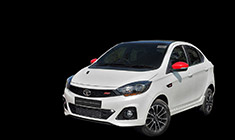News
Tata Punch.ev : Our observations after a day of driving
Get on the highway and the Punch.ev is surprisingly capable. Cruising at highway speeds is not at all stressful for the motor. Getting up to cruising speeds is an easy affair and the absence of any sound means you will reach triple-digit speeds without realising it.
Driving the Tata Punch.ev Long Range
Permanent Magnet Synchronous Motor in the Punch.ev Long Range puts out 121 BHP and 190 Nm of torque. You get a 35 kWh battery pack with the Long Range variant that gives the Punch.ev a claimed range of 421 km.
One of the biggest gripes we had with the regular Punch was that the petrol engine was underpowered and lacked “punch”. With the electric version, the hopes were high and Tata has stood up to those expectations by providing this 121 BHP motor. Push the engine start button with your foot on the brake pedal and the car is “Ready” to move as is displayed on the MID. There are four transmission modes to choose from: P, R, N and D. Engage D, lift your foot off the brake pedal and the car crawls forward. Since there’s no clutch, the car rolls off the line very smoothly and this is highly appreciable in heavy traffic conditions where you can drive with just the brake pedal.
Start driving with a light foot on the pedal and you will notice that the accelerator pedal’s response is linear and not snappy. Especially driving in Eco mode, the acceleration is very smooth and passengers will appreciate the jerk-free drive. There are no gearshifts or engine sounds which means that the driving experience is very refined. Light to medium throttle inputs are enough to keep up with the city traffic and close gaps to the vehicles in front. Floor the accelerator pedal and you'll be greeted with instant power/acceleration. This is the beauty of powerful electric motors. The car is quick and has abundant torque right from the get-go. Tata claims a 0-100 km/h time of 9.5 seconds and a top speed of 140 km/h, which are believable figures. You can easily make those quick overtakes in the city.
Get on the highway and the Punch.ev is surprisingly capable. Cruising at highway speeds is not at all stressful for the motor. Getting up to cruising speeds is an easy affair and the absence of any sound means you will reach triple-digit speeds without realising it (it's only when the speed warning chimes sound that you know you're doing 80 km/h and 120 km/h). The car feels very comfortable on the highway and you can cover good distances in the Punch.ev. Overtaking is also not an issue as you can just bury the accelerator pedal and you're off! The car doesn’t run out of breath in the middle of an overtake and you can easily get past most cars. Keep in mind that if you drive hard, the range drops drastically. This is also why you will see EVs that are driving long distances, stick to the middle lane and cruise at 80-100 km/h (which is the best cruising speed for the current lot of EVs).
There are 3 driving modes to choose from. They're mapped specifically for different driving styles. What’s appreciable is that the motor's characteristics are distinct in each mode.
City Mode: The default mode. The car always restarts in this mode, no matter what mode you last drove in. It's great for driving in the city as well as on the highway. Strikes a good balance between power and economy.
Eco Mode: The mode to engage when you want the maximum range. The throttle response is dumbed down, which results in a smoother drive in the city (less of that "torque-pull" effect). Power comes in more gradually when you ask for it. While there's enough grunt for day-to-day driving or cruising on the expressway, when you need to pull off a quick overtaking manoeuvre, you will want to engage one of the other modes.
Sport Mode: The mode when you really want to have fun. Floor the A-pedal in Sport mode and watch the traction control warning light flash in the instrument cluster. In this mode, the throttle response is sharper, and the car just feels more eager to get a move on. However, it can feel too peaky for city driving and also eats up the battery faster. Use "Sport" when you're looking for fun on expressway runs.
Regenerative Braking
There are 4 levels of regenerative braking which can be adjusted using the paddles placed behind the steering wheel. We absolutely love adjustable regen settings as we can tune them to suit our mood. On level 0, there is no regeneration. On levels 1 and 2, there's obviously lesser resistance when you lift off the accelerator pedal. Driving on level 3 enables maximum regeneration. Jaggu enjoyed driving on maximum regeneration mode. You can also do one-pedal driving in many situations. However, do keep in mind that the car will never come to a complete halt. It will keep crawling forward without any throttle input.
Noise, Vibration & Harshness (NVH)
There is no engine noise at all. The only sound coming is a faint whine from the electric motor at high revs. With no gearshifts & minimal mechanical parts, there are no jerks or vibrations. On the highway, tyre noise starts creeping into the cabin at 80 km/h. You'll hear it more because there is no engine sound to drown some of it out. Around 90-100 km/h, we could hear some wind noise. Again, more noticeable because there is no engine sound.
Range
Tata claims a range of 421 km with the 35 kWh battery pack. However, these numbers are very subjective and the real-life range solely depends on how you drive the car. ~300 km should be doable IMHO thanks to the better battery packaging. Can go lower, depending on how you use the accelerator. We await real-life reports from BHPian owners of this car.
Charging
The Punch.ev gets the industry-standard CCS 2 charging port. The Punch.ev with the 25 kWh battery pack is available with a 3.3 kW AC wall box charger that can charge the battery from 10-100% in 9.4 hours. You can opt for a 7.2 kW AC fast charger which can do the same in 3.6 hours. When on the road, you can choose a 50 kW DC fast charger to charge from 10% to 80% in 56 minutes.
The Long Range Punch.ev with the 35 kWh battery pack with the 3.3 kW AC wall box charger takes 13.5 hours to charge from 10-100%. The same on a 7.2 kW AC fast charger takes 5 hours. With a 50 kW DC fast charger, you can charge from 10 to 80% in 56 minutes. GTO thinks a 15A charger is all that 99% of owners will need - his article on the same.
Suspension
Ride Comfort
The Punch.ev comes with a McPherson strut suspension at the front and a twist beam suspension with coil springs at the rear just like the regular Punch. Like most EVs, the suspension tune is on a stiffer side thanks to the extra weight of the battery pack. However, the suspension tune is not bone-jarring. It is compliant and very much liveable. While you are always aware of the surface you are travelling on, the Punch.ev handles obstacles and potholes on the road very well. The suspension feels very robust and abuse-friendly.
You have 16" rims shod with 195/60 section tyres. Lower variants with the 185/70 R15 tyres will have a better ride due to taller tyre sidewalls. Further, the recommended tyre pressure is 34 PSI; you can drop it down while driving in the city for a cushier ride. The good thing about such a suspension tune is that the car doesn’t bounce around at 80-100 km/h. For a small crossover, it rides pretty nicely on the highway @ 100 km/h and feels stable.
Handling & Dynamics
We had mentioned in the Punch review that the suspension setup and chassis can handle a lot more than the 1.2 NA petrol has to offer. That problem has been sorted in the Punch.ev with the 121 BHP motor. The straight-line stability is satisfactory and the car doesn’t feel nervous even at 120 km/h. You can easily carry good speed around long curves and the car will hold its line well. Body roll is well controlled and thanks to the almost 50:50 weight distribution, the car doesn’t feel nervous during direction changes from one curve to another. We even tried a slalom course and the car managed to keep its composure. The only thing that holds you back are the low rolling resistance EV tyres. They squeal in protest whenever you try to push the car hard into corners.
Steering
The electric power steering is one of the nicer units around. It is light at city speeds and weighs up sufficiently as the speed increases. The EPS isn't lifeless and does give you some feel of what the front wheels are up to. That being said, the steering isn’t particularly sharp or precise. Enthusiasts will expect more feedback and a connected feel from the steering. There’s also a weird steering behaviour that we’ve noticed in some other Tata cars as well - the steering weight feels inconsistent. There is a point at ~70-80 km/h when the steering suddenly weighs up. The transition is very evident and can catch you off-guard at times.
Braking
While the Punch.ev comes with disc brakes at the front and drums at the rear, the Punch.ev Long Range gets an all-wheel disc brake setup. The brakes provide excellent stopping power. Emergency braking situations are handled well, and the car is brought to a halt from high speeds effectively. Besides, the car is equipped with ABS + EBD, corner stability control, disc brake wiping, and panic brake alert. The pedal feel is consistent and doesn’t take long to get used to.
Continue reading the discussion on the Tata Punch.ev on our forum.
- Tags:
- Indian
- Launches & Updates
- Tata
- Punch EV
























